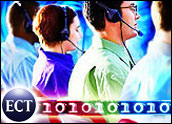
Contact center managers for years have been using tried-and-true efficiency-oriented key performance indicators to measure contact center success, such as average call handling time and cost-per-call.
The Aberdeen Group completed a benchmark survey in May that examines the trend of Fortune 100 Best-in-Class companies that are transforming their contact centers from cost centers to profit centers. The findings are eye-opening: Best-in-Class companies want and are achieving trusted-partner status, but to do this, they have to rethink success in the contact center and build on existing strategies.
Reaping Benefits
The good news: There are some significant benefits to rethinking the transformation to a profit center correctly. Aberdeen’s findings indicate that under the corporate mandate of providing trusted advisor status and making customer service a competitive differentiator, these Best-in-Class companies have also reaped significant additional benefits:
- Eighty-one percent have increased brand awareness and lock-in;
- Seventy-eight percent have increased customer retention;
- Seventy-six percent have increased average revenue per customer; and
- Sixty-eight percent have increased customer satisfaction.
The study also indicates the delicate balance that companies face as they examine the risks and rewards of cross-sell and upsell: The right incentive system for agents balances issue resolution and sales. Agents that cross-sell have fewer and longer calls as a result of trying to execute a successful sale.
This goes directly against traditional contact center culture, and unlike a traditional contact center issue — which can be escalated — there is no escalation in sales mode. Additional challenges abound: Agents can be incented more by the sales bonus than issue resolution. They may not fully understand the full suite of products and services they can offer to the customer, and they can attempt to sell only at the right time and right conditions in the interaction.
Necessary Actions
You will need to build on what you have in place but don’t throw out what has already been successful. There are two strategic actions, which are necessary:
- You will need to align your contact center goals and key performance indicators with corporate revenue and profit goals, and
- You will need to provide comprehensive sales training for contact center agents.
There is a series of organization, process, technology and performance levers, which these Best-in-Class companies have used to make the transition effective, according to the study:
- From a process perspective, 48 percent enable 24/7 access to contact center agents.
- From an organization perspective, 57 percent of these agents are empowered to decide when the time is right to sell.
- From a technology perspective, 62 percent use analytics integrated with their baseline CRM system(s), 57 percent use some sort of knowledge management and 33 percent use e-learning tools.
- From a performance perspective, 100 percent measure cross-sell and upsell performance, 82 percent measure customer satisfaction and 83 percent measure initial sales.
A key differentiator between Best-in-Class and other firms is the empowerment that Best-in-Class give to CSRs (customer service representatives) not only to solve problems but also to sell products and services to address customer needs. These Best-in-Class companies are far more likely to allow agents to decide when the time is right to cross-sell or upsell. This is a critical capability, and timing is everything: If an agent realizes an opportunity to make a sale but is not empowered to act on it, a sale could be lost. Transferring the call to a sales rep increases the time the customer spends on the call and decreases the likelihood of a successful sale.
Technology is a critical supporting component. Knowledge management provides agents with:
- Scripting to walk the agent through the sales process;
- Querying to quickly and accurately find information that can solve a customer issue and help lead to a cross-sell or upsell;
- A knowledge base of centralized data and access to standardized prior customer responses; and
- Analytics allow for the tracking of past and current performance and forecasting to management via dashboards.
Interestingly enough, only 25 percent of even Best-in-Class have implemented a unified communications strategy to be able to integrate IM (instant messaging), chat, wiki and other collaborative technologies with baseline telephony. Best-in-Class companies use this as an essential technology enabler to successfully upsell and cross-sell.
Building on Existing Strategies
In addition, network with others on this journey and don’t over-rely on technology to help you — you need to hire the right people, monitor their performance and provide the oversight coaching and selling they need to develop.
Done correctly, this can also be extremely profitable — by aligning you goals, by training, by implementing correct process, organization, technology and performance KPIs, this can also be extremely profitable.
On average, these Best-in-Class companies were 28 percent more profitable than the median in their industries.
In summary, you don’t have to throw out everything you’ve learned about contact center management to make this work; however, you do have to build on your existing strategies.
David Boulanger is a research director in the customer management strategies group at Aberdeen Group. He can be reached at [email protected].













































